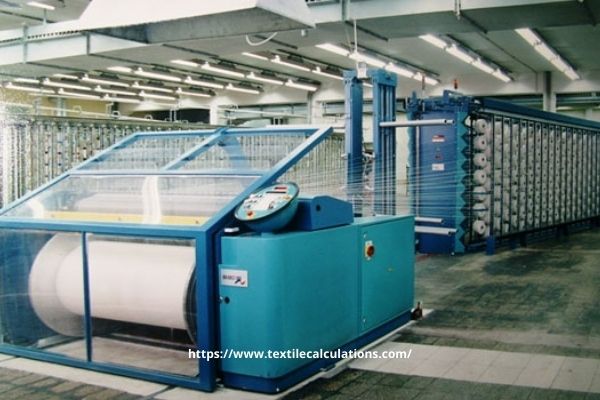Warping:
Warping is defined as the parallel winding of yarn from a cone or cheese package onto a warp beam. The operation of winding warp yarns onto a beam usually in preparation for slashing, weaving, or warp knitting. Also called warping. In this article, we will discuss different formulas of warping calculation with examples.

Different Formulas of Warping Calculation with Examples
1. Count Of warp yarn,
…..The total length of yarn in hanks
= ………………………………………………….
………………..Weight in lbs
Or,
…..Length of warp in hanks × number of ends
= ……………………………………………………………….
……………………….Weight in lbs
Or,
….Length of warp in yds × number of ends
= …………………………………………………………..
………………..Weight in lbs × 840
Example:
Calculate the count of yarn on a back beam that weighs 303 lbs. and has 12000 yards of warp on it. The total number of ends in the warp is 420 and the weight of the empty beam is 63 lbs.
Solution:
Count Of warp yarn,
…..Length of warp in yds × number of ends
= ……………………………………………………………
……………………Weight in lbs × 840
…..12000 × 420
= ……………………
……240 × 840
= 25’s cotton.
So, the count of yarn on a back beam is 25s cotton.
2. Total length of Yarn in warp,
= length of warp × number of ends
Example :
A warper’s beam produced on an improved modern high-speed beam warping machine contains 39780 yds of warp with 420 ends. If the net weight of the warp on the beam is 663 lbs, calculate the beam count.
Solution:
The total length of Yarn in the warp,
= length of warp × number of ends
…..39780 × 420
= …………………….. (hanks)
………….840
= 19890 hanks
Count,
…..The total length of yarn in hanks
= …………………………………………………..
………………..Weight in lbs
……19890
= …………….
………663
= 30’s cotton
So, the beam count is 30s cotton.
Warp yarns run with the length of fabric and weft yarns go across the width of the fabric. Warping is the preparation of yarn to weave fabric. It is the transfer of many yarns from the creel of single packages to a beam. The yarns will form a parallel sheet of yarn wound onto the beam. The basic objective of warping is to build a package where the yarn ends remain in uniformly set parallel & continuous form.

